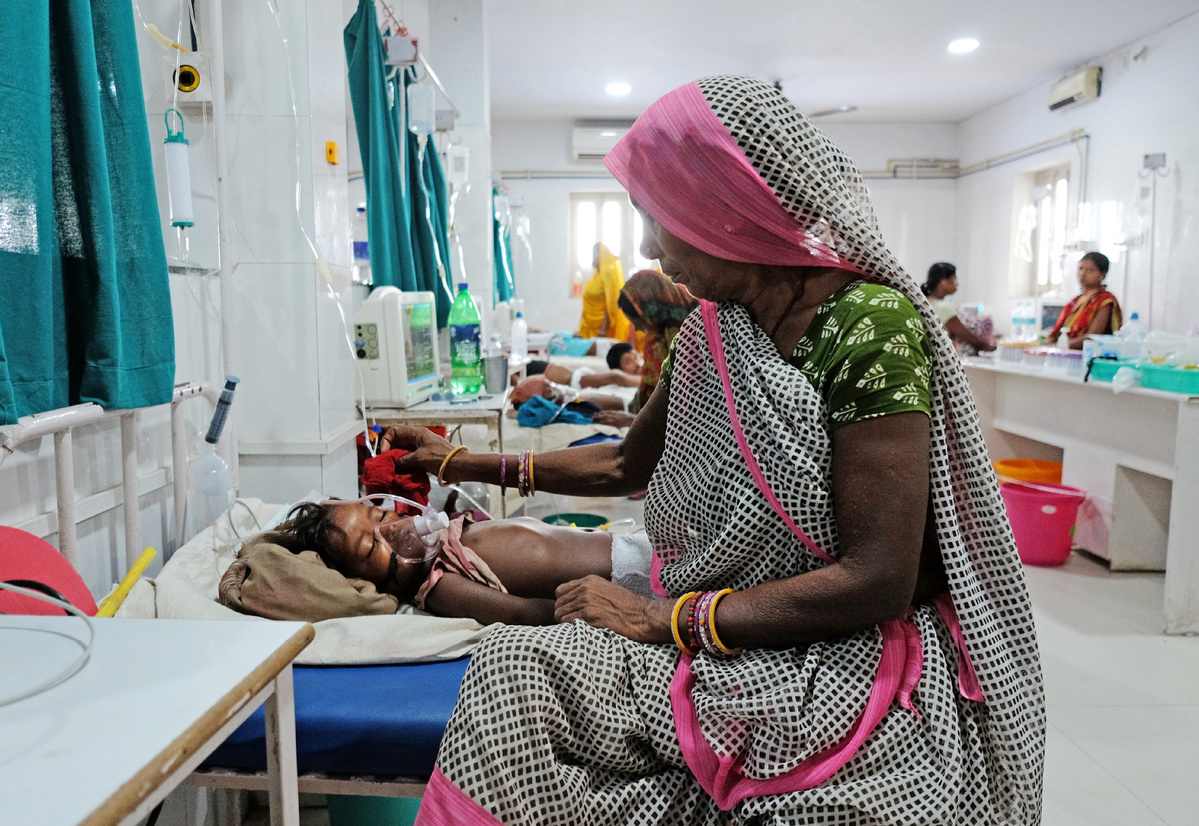
A relative sits next to a child patient who is suffering from acute encephalitis syndrome at a hospital in Muzaffarpur, in the eastern state of Bihar, India, June 20, 2019. (Photo: Agencies)
At least 160 deaths of children in eastern India in the past two months are likely due to acute encephalitis. Much to the relief of the authorities, the flow of patients at the local hospitals has fallen sharply as the monsoon rain wanes.
Most of the deaths were reported from Muzaffapur, a northern town in India's Bihar state. Health officials said the children died due to loss of glucose and dehydration. They added that most of the children suffering encephalitis attacks, in which the brain becomes inflamed, were severely malnourished.
A total of 637 cases of suspected encephalitis were reported this year, out of which 160 children died.
"The encephalitis outbreak normally takes place when there is intense heat and humidity but now that the temperature has come down after monsoon rains, its impact has slowed down," said Gopal Shankar Sahni, head of pediatrics department at Sri Krishna Medical College and Hospital, the only state-run advanced medical facility equipped to treat encephalitis cases in Muzaffarpur.
"We are feeling relaxed now with most of the patients returning home after treatment," added Sahni, who has been conducting research on this disease since 2005.
Authorities, however, have launched massive development works to provide housing, rations, clean water, toilets and also food for poor children with the goal of combating malnourishment, which is one of the factors blamed for encephalitis outbreak. The disease most commonly affects children and young adults.
The initiatives are a response to an extensive social-economic survey of 538 families which are suspected to have been affected by encephalitis.
"Massive development works have been launched in the areas. This is a long-drawn-out process which will sure to contain the annual outbreak of disease claiming many lives of children every year," said Sunil Kumar Shahi, the superintendent of Sri Krishna Medical College and Hospital in Muzaffarpur.
Under part of the initiatives, the hospital authorities have been told to provide all facilities, from housing to nutritious food, to the affected families in three months. An extensive awareness campaign was also launched to counsel the villagers in the care of children during intense heat period.
The government is also constructing a 100-bed pediatric intensive care unit on the Sri Krishna hospital campus. It will be ready by next April, the month when the disease normally hits the region.
Health officials said encephalitis first seems to have struck the region in 1995 and it has claimed 474 lives in the state so far, yet it has yet to be fully identified and brought under control. The disease strikes during summer and turns deadlier with rising temperatures.
Doctors treating the affected children describe the disease as acute encephalitis syndrome, causing inflammation of membrane of the brains. That leads to sudden fever which can cross 40 C, headache, disorientation, tremors, convulsion, vomiting and paralysis. The ultimate cause may be a viral, bacterial or fungus infection.
Doctors conducting research on this disease, however, have not found any connection between the disease and the luscious lychees which are abundantly grown in the region.
"I have been treating the patients suffering from this disease for the past 14 years. I also conducted a research on this disease in 2005. It has nothing to do with lychees. The disease occurs primarily due to high temperature and humidity," Shani said.
The director of the National Research Centre on Litchi, Vishal Nath, also asserted that the fruit had no role to play in spread of this disease. He said lychees are blamed for no reason and have no element that could harm people.
"The big question now is why children in other parts of the country not falling sick after eating lychees? Bihar only contributes to just one-tenth of lychee production," he asked.
Yet the rumors had badly affected the business of the state's lychees farmers. One grower, Bholanath Jha, blamed the mango lobby for spread of such rumors against litchis.
"Lychees are being blamed for this disease under part of a conspiracy. Mango lobby is involved in this conspiracy," he alleged. "While mango remains available at barely Indian rupees 30-40 ($0.42-0.56) a kilogram, lychee is sold at the rate of Indian rupees 200-250 a kg, depending on their quality."


